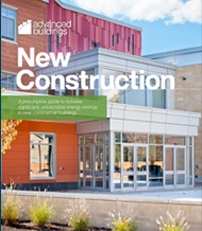
by Brianna Crandall — July 13, 2015—New Buildings Institute (NBI) and Architecture 2030 announced in recent weeks that Architecture 2030 has endorsed a prescriptive path to meet the current 2030 Challenge energy reduction goal based on NBI’s Advanced Buildings New Construction Guide. With this path, design teams now have another tool when seeking to meet the 2030 Challenge.
The New Construction Guide has also been incorporated as the prescriptive path to comply with the energy prerequisites for both the U.S. Green Building Council’s (USGBC) Leadership in Energy and Environmental Design (LEED) v4 green building certification program and the Northeast Collaborative for High Performance Schools Criteria (NE-CHPS). The guide has also been adopted as the basis for the prescriptive path for complying with the energy code in the City of Boulder, Colorado, currently the most stringent in the country.
Influential nonprofit research organization Architecture 2030 issued the 2030 Challenge in 2006 to focus the building sector on energy reductions through the setting of achievable targets. The Challenge’s final goal is that all new buildings and major renovations be carbon neutral by 2030. With its series of targets aimed at reducing the use of fossil fuels, the 2030 Challenge has been adopted and is being implemented by 80 percent of the top 10 and 70 percent of the top 20 architecture/engineering/planning firms in the USA, says the group.
The current 2030 Challenge target calls for all new buildings, developments and major renovations to be designed to meet a fossil-fuel, greenhouse gas (GHG)-emitting, energy-consumption performance standard of 70 percent below the regional (or country) average/median for their relevant building type.
The Advanced Buildings New Construction Guide is NBI’s prescriptive design guide for small commercial buildings. It is a whole-building design guide that combines design guidance with tens of thousands of building energy simulation models to offer a pre-assembled integrated design package that promises to deliver significant savings over the latest versions of ASHRAE Standard 90.1 and the International Energy Conservation Code.
A series of increasingly stringent tiers allows the guide to deliver savings in a national landscape where states and local jurisdictions have energy codes with drastically different levels of stringency while also providing greater levels of energy efficiency to projects seeking higher performance, explains NBI.
Combining the New Construction Guide‘s inherent flexibility with limited onsite renewable energy, NBI’s pathway to meeting the current 2030 Challenge target offers various options. Each is based on an aggressive energy efficiency strategy such as advanced daylighting, superinsulation, advanced lighting design or advanced heating/ventilation/air-conditioning (HVAC) system selection. This allows design teams to choose the strategy that best suits the needs of each individual project.




